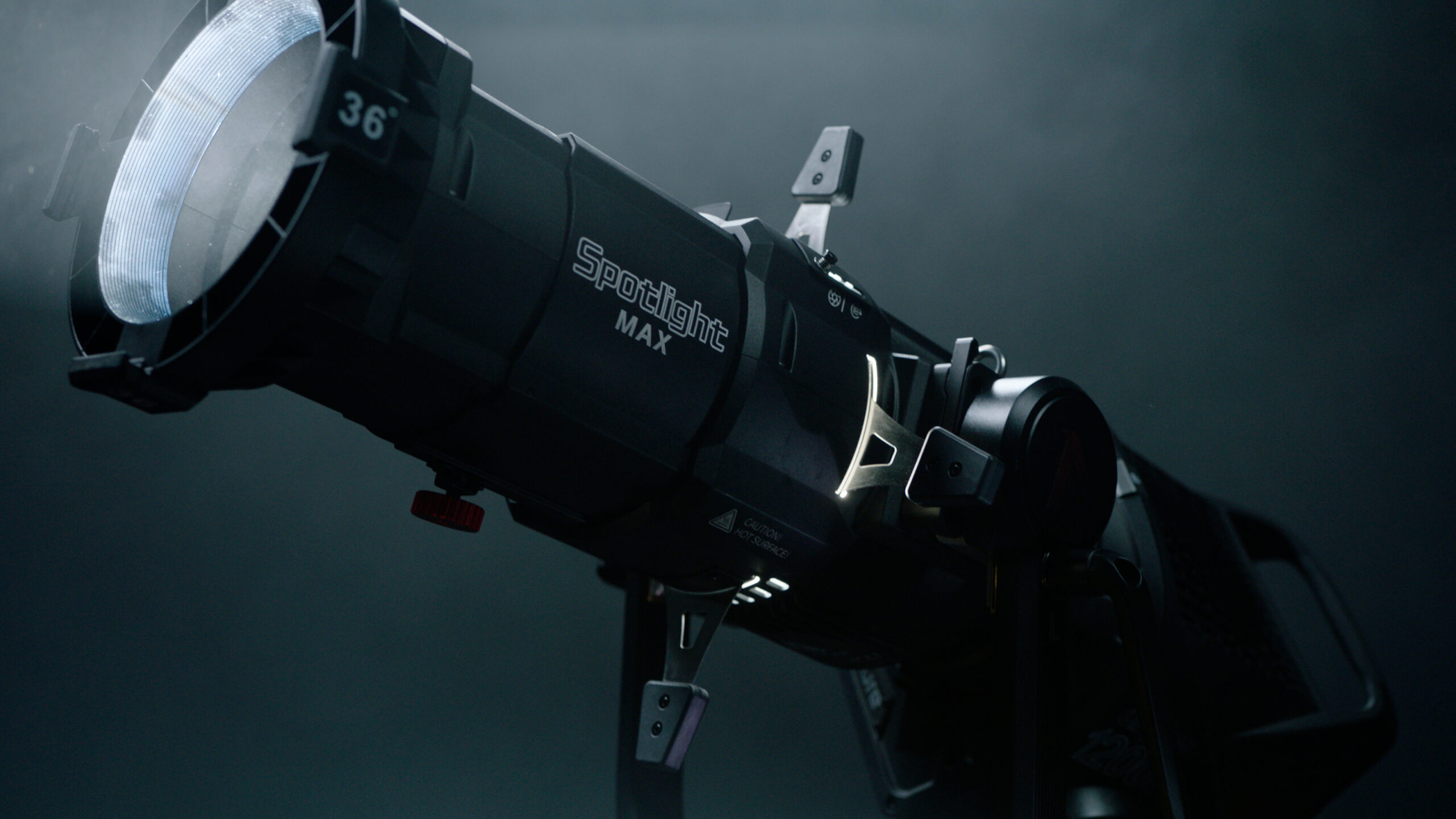Aputure’s Industry-Leading LED Spotlight Attachment, Tested & Compared
Aputure’s new Spotlight Max answers the need for a high performance projection attachment for larger COB spotlights, and includes several innovations that answer client requests. The most basic need was for a projector that worked well on COB lights with a large diameter emitter surface, such as the LS 600 series fixtures. Additionally there was the need for precision adjustment of gobos and lastly while everyone wants the finest optics possible they also want the option of the convenience and versatility of using the wide range of available lenses they may already own from legacy ellipsoidal projectors. The Spotlight Max answers all of these needs and does so with unprecedented optical performance.
What is a Spotlight?
A Spotlight is what Aputure calls a projection lens system. It mounts in front of a COB light fixture and uses optics to project a focused beam of light. The projector is optically collimated so that the light can be focused on a plane in the distance, much like a photographic lens on a camera. Within the Spotlight, behind the optical nodal point, are modifiers to the beam that can be brought into clear focus in the projection. These can be four-sided cutters to shape the outer edges of the beam, an iris mechanism to limit the light in a circular frame, and a tray or slot for Gobos, which are metal or glass plates with pattern cutouts. Just as on a camera, different lenses in the Spotlight render different magnifications to output various-sized projections of light.
What are the photographic uses of a Spotlight?
The two most common uses for a Spotlight are direct and indirect projection. In direct projection, the beam itself is visible within the image. A precise beam can highlight an object, backlight a subject, key a subject with a hard focused spot, emulate a ray of sunlight through a window, or project a pattern on a wall.
With indirect projection, the lack of spill and the concentration of a large quantity of light are the key attributes of the Spotlight. A reflector or bounce card can be placed where it may be difficult or unsafe to mount a light fixture. When the Spotlight “punches” into the board, it creates a new light source to shine onto the scene.
Why does Aputure offer three different types of Spotlights?
A Spotlight’s performance is defined by its lens design. The design of each optical path is optimized for a specific use and specific size of COB light source. Here are the three models of Spotlights available from Aputure:
Spotlight Mini Zoom
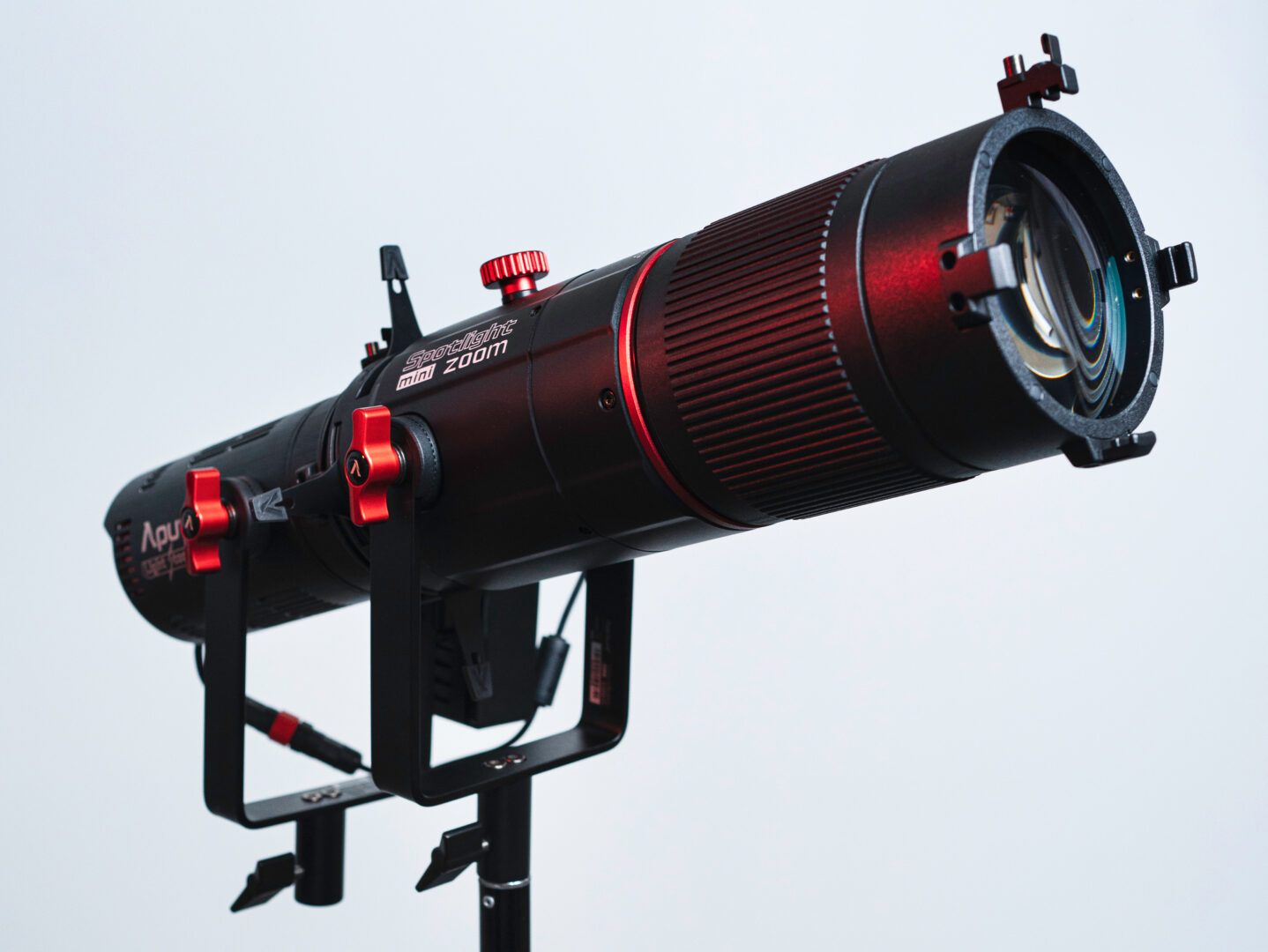
This projector is designed to work with the built-in optics of the LS 60d and LS 60x lights. It features adjustable optics for a 15°-30° beam spread and is physically designed around the diminutive size of the lights for a compact package.
Spotlight Mount
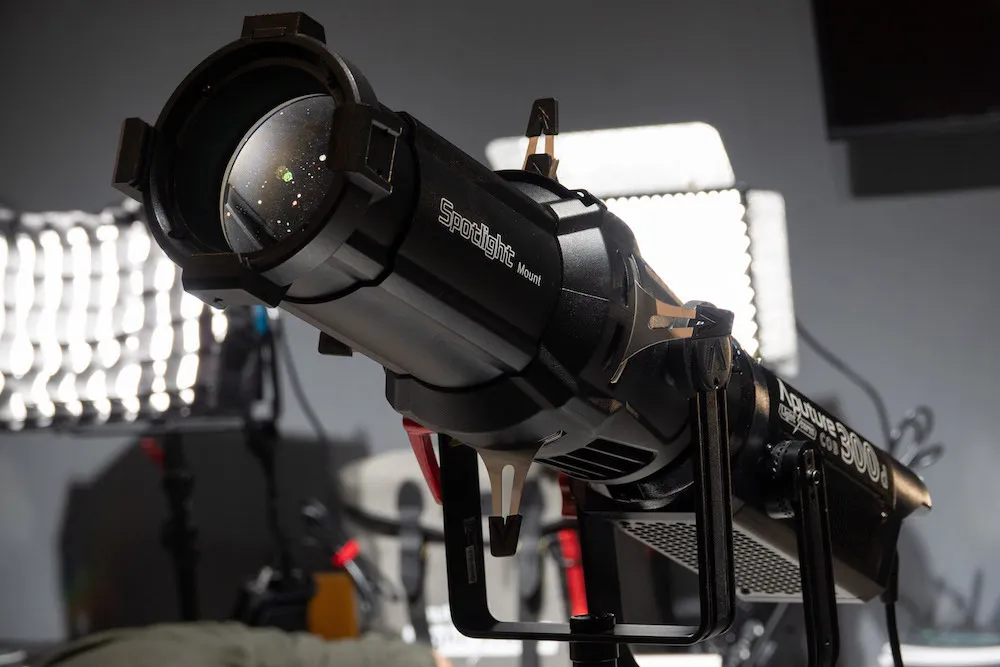
This projector is optimized for lower wattage lights, such as the LS 120 and LS 300 series lights from Aputure. Their relatively small COB diameters result in a projector that is efficient and bright while remaining physically small enough to mount to standard “baby pin” light stands. There are three lenses available with beam angles of 19°, 26° and 36°. If a Spotlight Mount is attached to a larger COB light, the rear oculus of the projector will not allow all of the emitted light to pass, so the brighter light fixture may not yield a higher output projection as much of the light will be wasted.
Spotlight Max
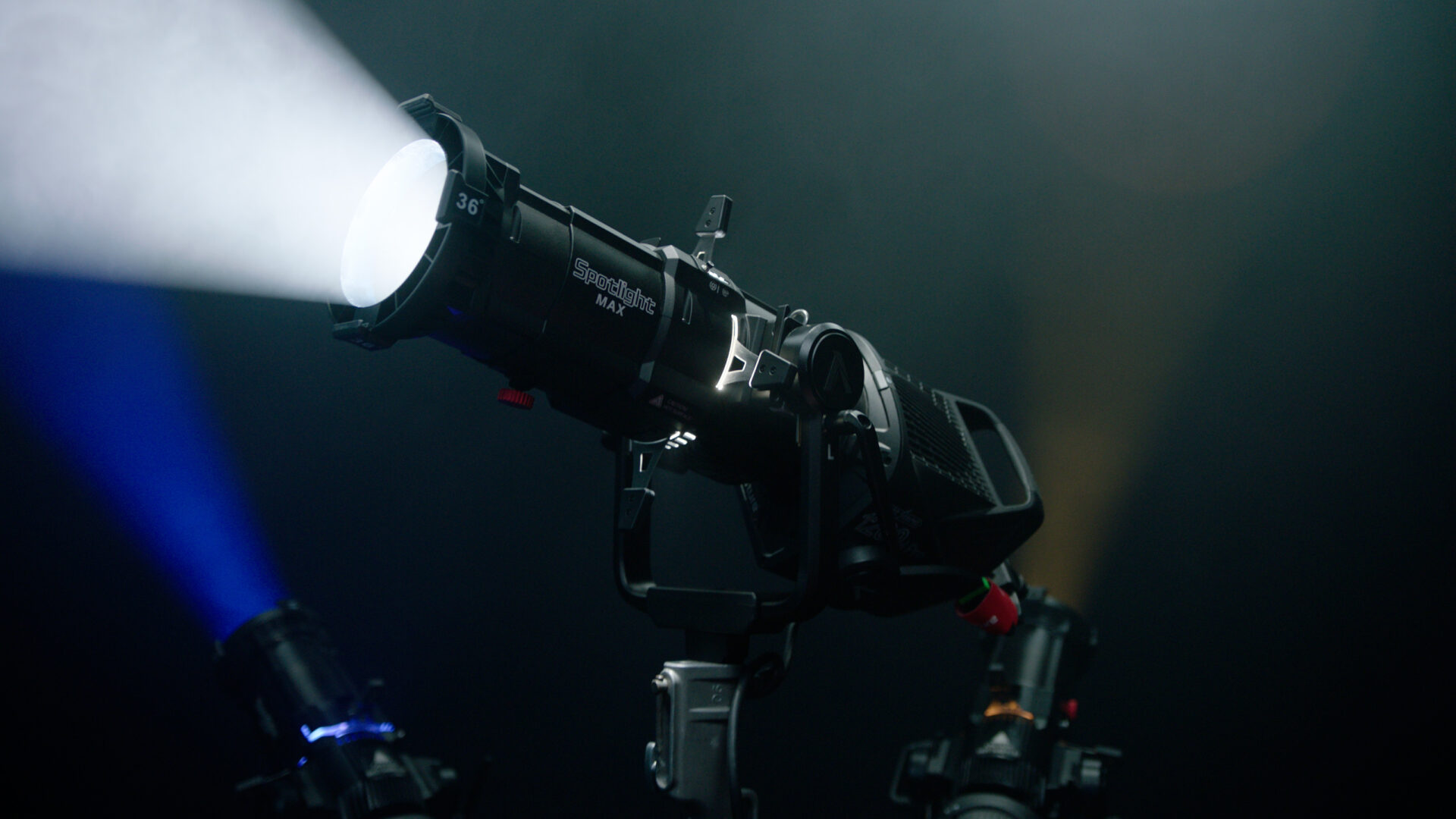
The Spotlight Max is designed for larger COBs, such as the Light Storm 600 series and above. The larger rear lens accepts the light from a larger diameter COB so that more light passes through the projector. Three lenses are available in 19°, 36° and 50°. Additionally, the Spotlight Max is optically and mechanically designed to accept legacy ETC Source 4 Leko standard and EDLT lenses through use of an Aputure ETC Adapter, opening up a wide range of available lenses from 5°-50°.
(Note that the Spotlight Mini Zoom uses a mount specific to the LS 60d and LS 60x lights, while the Spotlight Mount and the Spotlight Max both use a Bowens-mount to attach to a wider variety of light fixtures.)
Special features of the Spotlight Max
The Spotlight Max offers features never before available on a Bowens-mount projector. The unique design comes as a direct response to requests from our users.
Rotating Gobo Tray
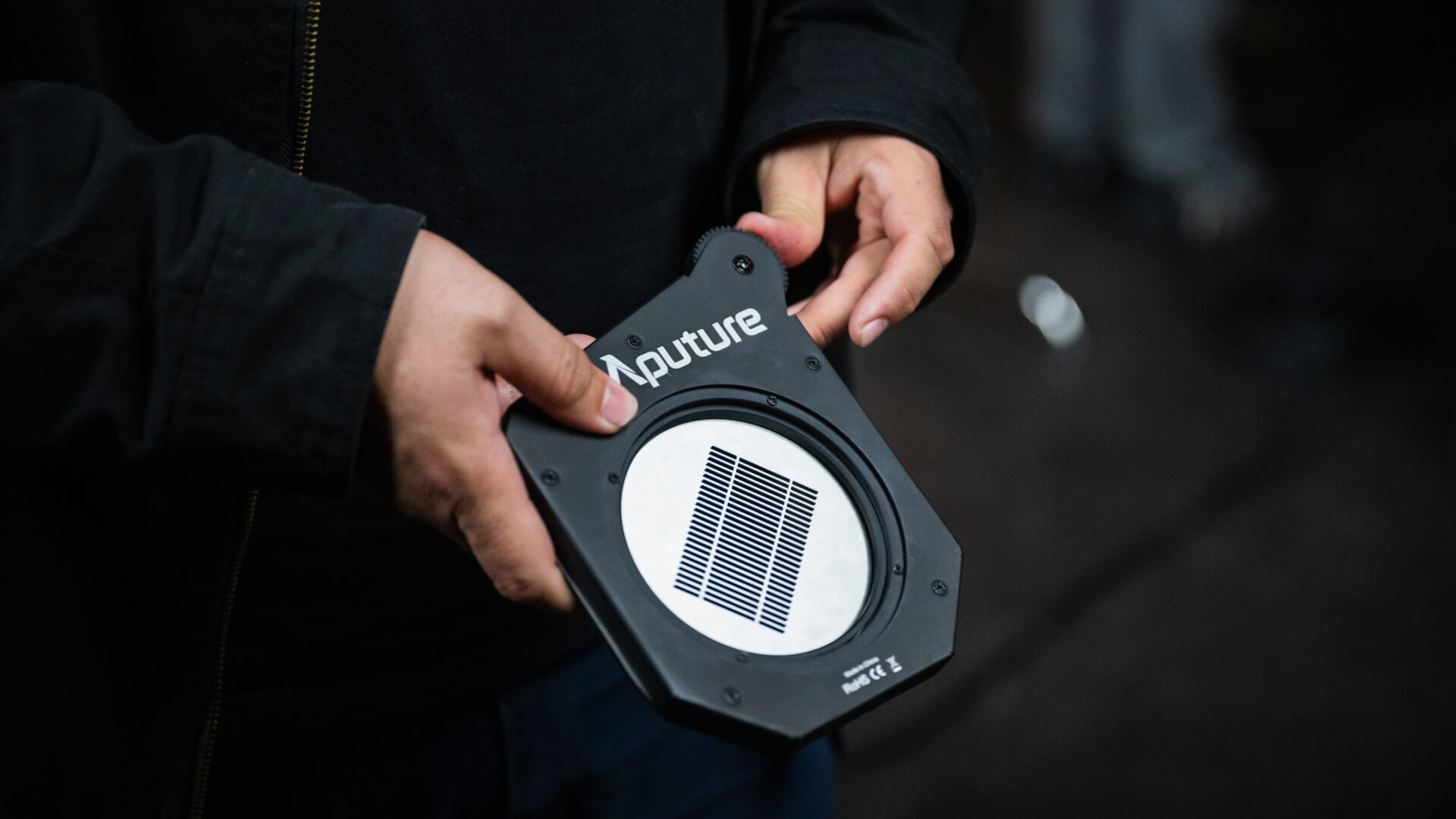
The Spotlight Max features multi-element, multi-coated optics with low-dispersion glass and a large diameter for increased light passage. These high-quality optics make for a heavy lens system, so a rotating lens barrel would have introduced flex and required larger and heavier mechanics. Instead, Aputure engineered a rotating gobo tray so that gobo patterns could be precisely aligned with ease.
ETC Adapter
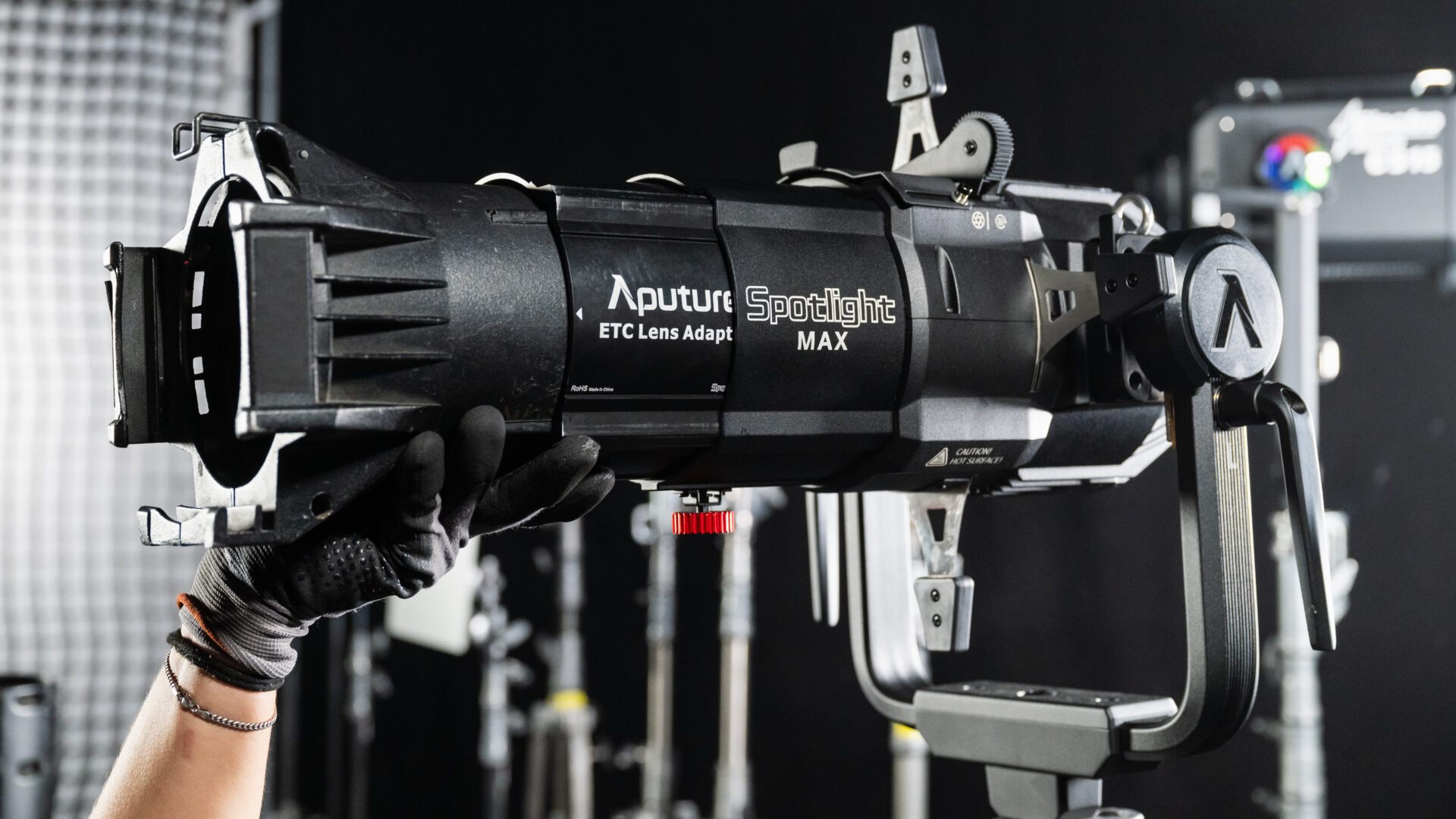
By expanding the projector barrel and utilizing a new optical assembly in front of the COB before the projector’s optical nodal point, the Spotlight Max can use a simple mechanical sleeve adapter to mount ETC Source 4 Leko standard and EDLT lenses. While the optical performance of these simpler lenses is not as high as the Aputure lenses, the ability to use a wide range of readily available lenses ranging from 5°-50° makes the Spotlight Max a highly versatile projection system. All of the tested lenses performed well with the exception of the ETC 36°. That lens exhibited a strange interaction with the optical path of the Spotlight Max that creates artifacts in intensity across the field and imaging contrast. We recommend using the Aputure 36° lens.
Spotlight Max optics v. traditional optics
The Spotlight Max features a new advanced optical design that is optimized for larger COB light futures such as the LS 600d. The optics of the projector were also specifically designed so that either Aputure dedicated front lenses could be used or, with the use of a mechanical adapter, ETC Source 4 Leko standard or EDLT lenses. Reverse engineering to accommodate the ETC optics meant creating a virtual light source within the optical beam path in the projector. The optics within the Spotlight Max comprise multi-coated low-dispersion glass elements with a wide aperture to allow maximum light transmission. In striving for the highest quality projection, the interchangeable lenses made by Aputure have more elements and are optically more complex than the traditional ETC lenses. This design upgrade yields: high contrast, greater resolving power, lower color fringing and chromatic aberration, less color shift, greater spill control, and more even field brightness and color. Perhaps most importantly for many, overall light transmission is generally higher when using the Aputure lenses, even compared to lenses of the same beam angle.
Even Beam Spread
A key metric of overall optical performance in a projection system is how even the beam of light is from the center to the edge. A bright hotspot in the center of the beam can give a false overall sense of the illumination level and can result in a projection effect that is inferior to the eye. No projector can produce a perfectly even beam for all COBs, since different COB sizes, native beam angles, and depths from their mounting surfaces all affect the way the emitted light enters the projector. But the less the falloff in the beam the better.
On the LS 600c, when testing at 5600K at 10’ on a 19° lens, these were the center-to-edge percentage drop off in intensity (% edge dimmer than the center):
Spotlight Max w/ Aputure 19°: 9.5%
Spotlight Max w/ ETC 19°: 33.3%
Nanlite PJ-BM w/ Nanlite 19°: 32%
Spotlight Mount w/ Aputure 19°: 38%
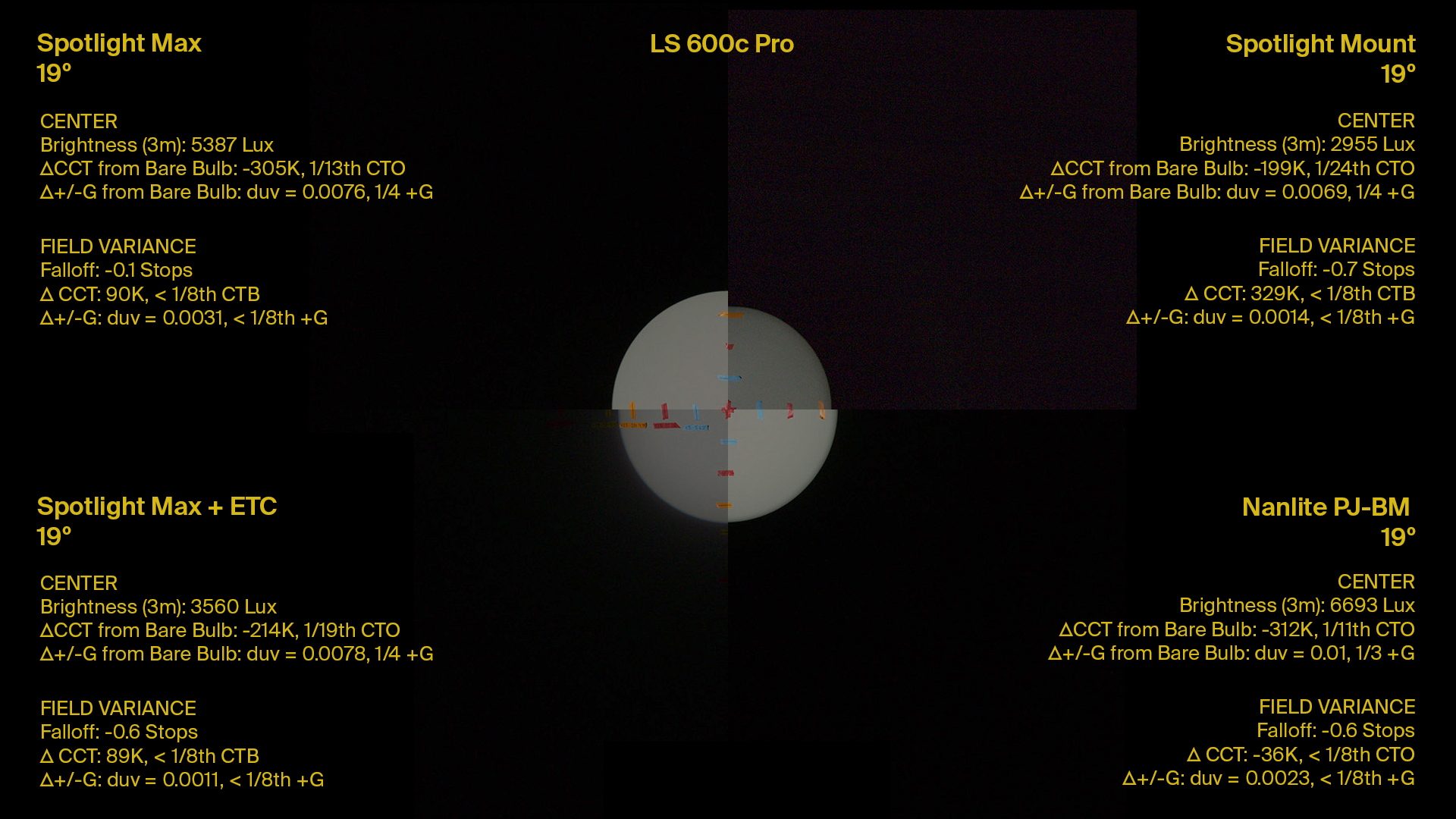
The significantly lower drop-off in intensity of the Spotlight Max paired with Aputure’s 19° lens makes for a beam three times as even in illumination across the field compared to other options. While some other lights may not exhibit as even beams with the Spotlight Max, the performance is consistently better than other systems.
LS 1200d at 10’ on a 19° lens (intensity falloff):
Spotlight Max w/ Aputure 19°: 18%
Spotlight Max w/ ETC 19°: 35%
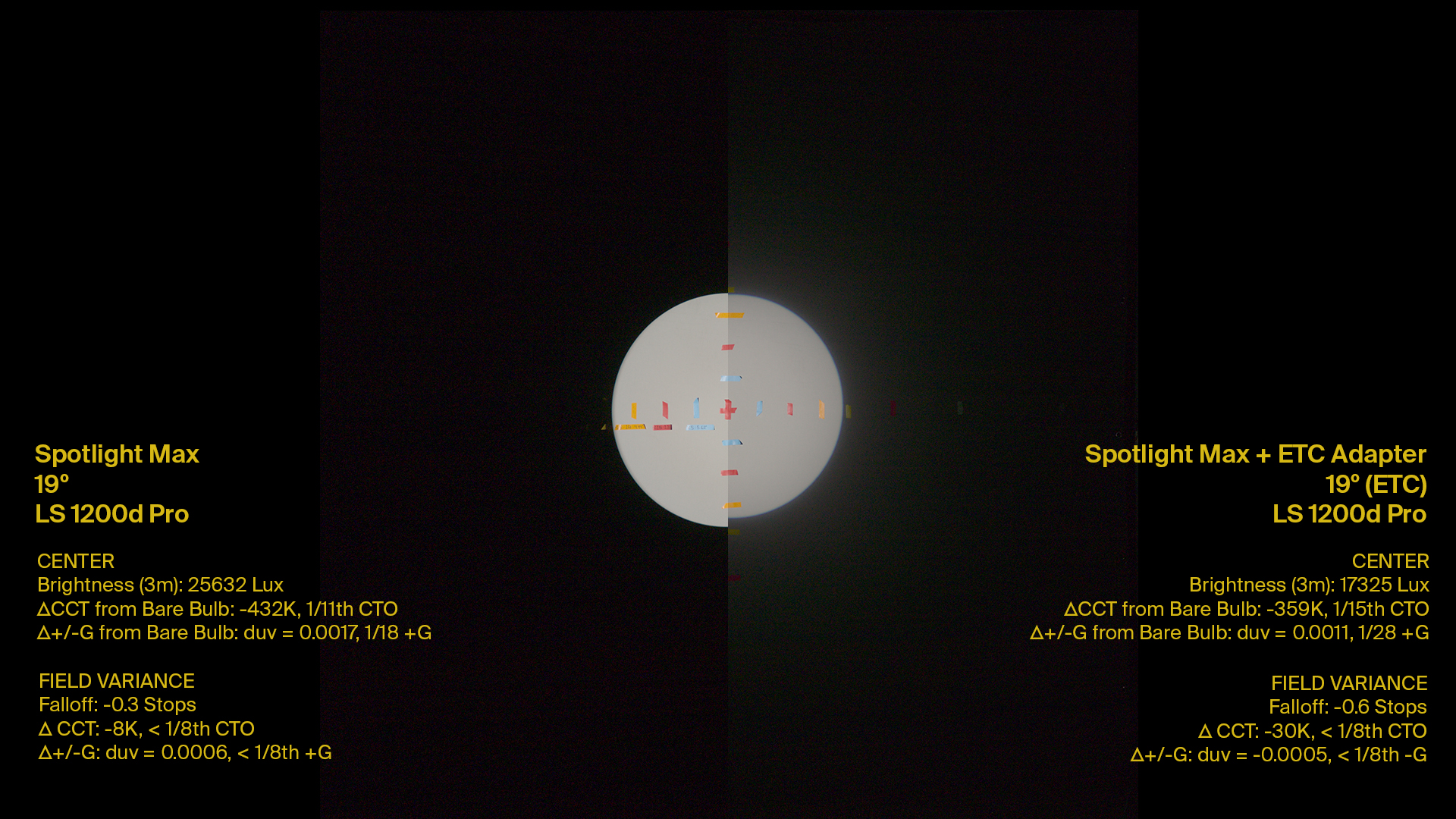
Electro Storm XT26 at 5600K at 10’ on a 19° lens (intensity falloff):
Spotlight Max w/ Aputure 19°: 15%
Spotlight Max w/ ETC 19°: 39%

For reference, let’s compare the above to traditional projector options, a 750w quartz tungsten ETC Source 4 Leko and an 800w HMI “JoLeko” (K5600 Joker 800 mounted to ETC. Source 4 Leko barrel).
Testing at 10’ on an ETC 19° lens (intensity falloff):
Source 4 Leko w/ ETC 19°: 41%
JoLeko 800 w/ ETC 19°: 60%
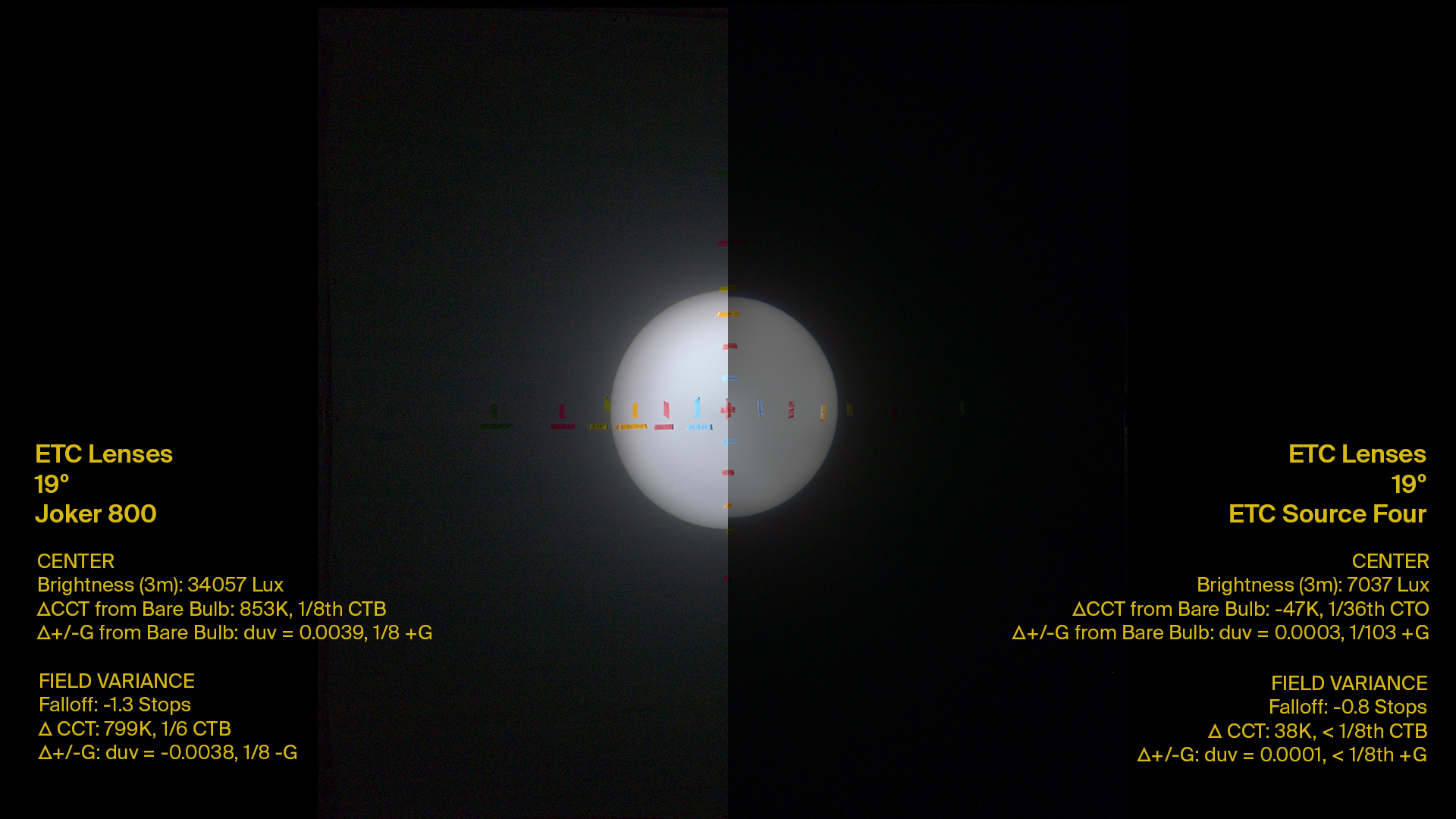
Wider beam lenses tend to have greater falloff in brightness due to the longer distances the light must travel to the edges, but even here the differences were less pronounced with the Spotlight Max and the Aputure lens.
LS 600d at 10’ on a 50° lens (intensity falloff):
Spotlight Max w/ Aputure 50°: 50%
Spotlight Max w/ ETC 50°: 84%
LS 600c at 5600K at 10’ on a 50° lens (intensity falloff):
Spotlight Max w/ Aputure 50°: 33%
Spotlight Max w/ ETC 50°: 82%
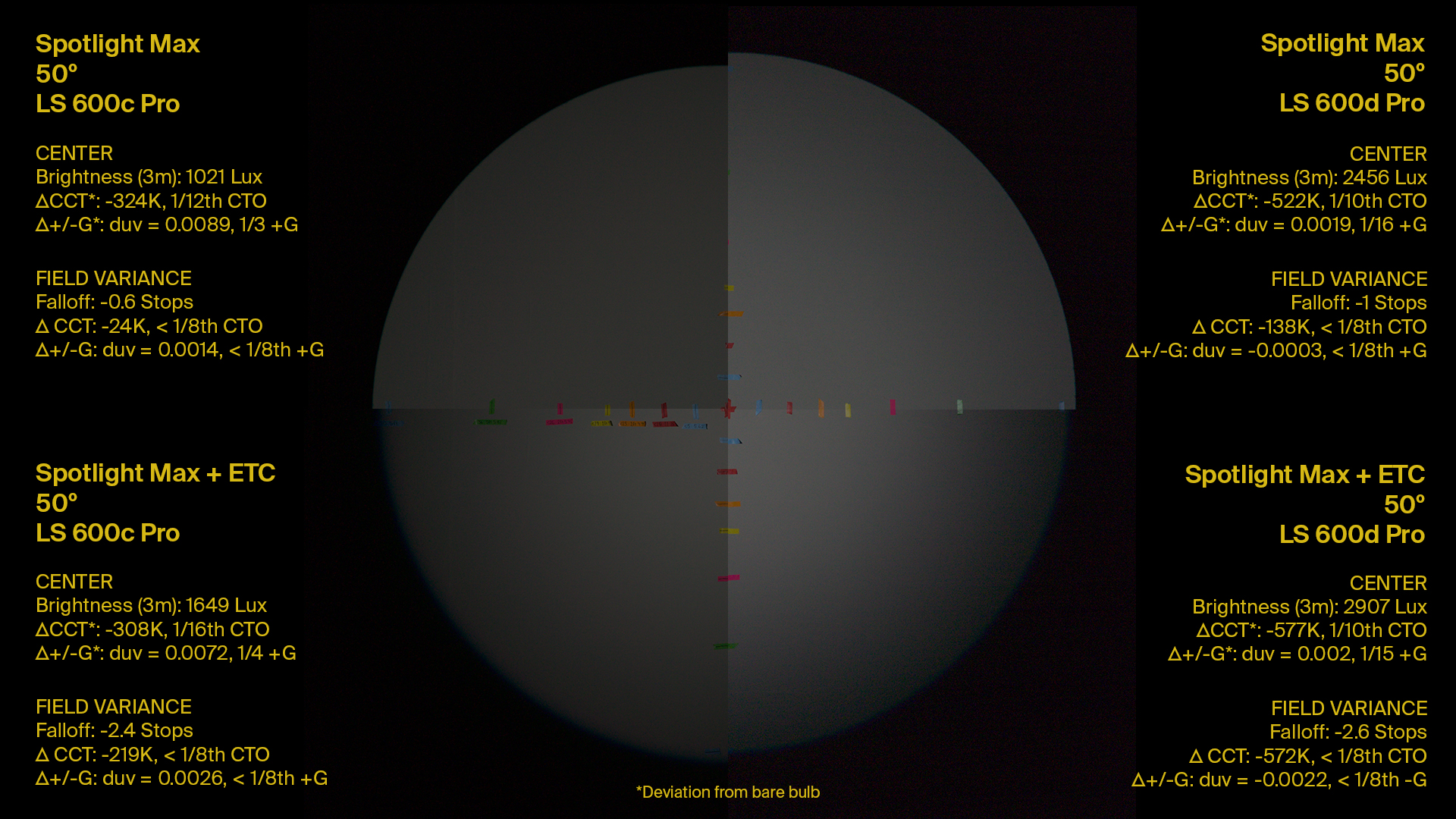
And for reference, the Leko and JoLeko on a 50° (intensity falloff):
Source 4 Leko w/ ETC 50°: 72%
JoLeko 800 w/ ETC 50°: 86%
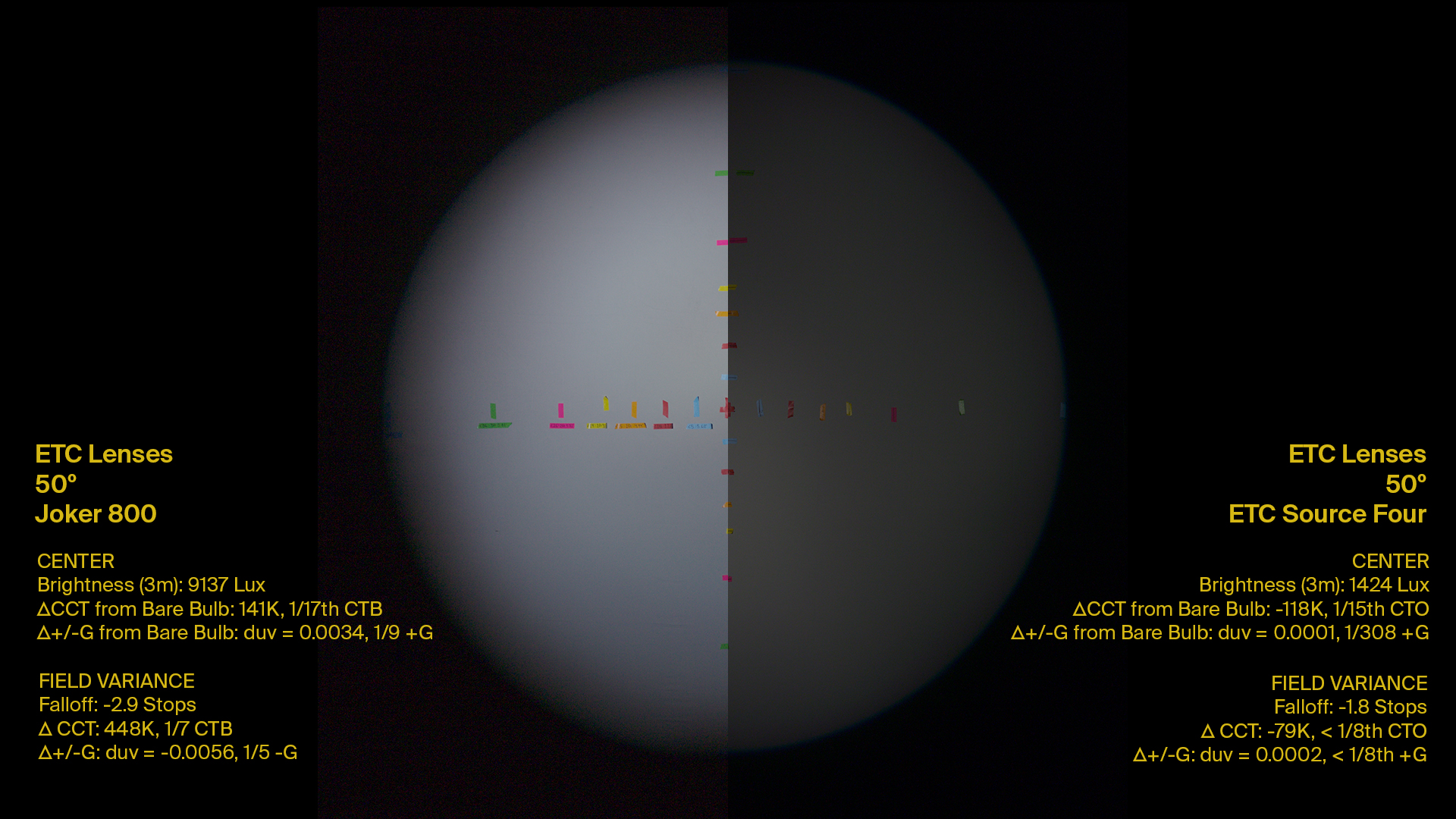
Clearly, the beam spread of the Spotlight Max with the Aputure lenses exhibits a more even beam spread than other options.
Color Shift Across Beam
The brightness level is not the only factor that can shift from center to edge in a projection beam. As light bends the wavelength can be altered, changing the color. Simpler optics using only a single lens element with an older optical coating design may exhibit greater color shift. The multi-element, multi-coating optics of the Aputure projection lenses maintain minimal color shifts across the projection field. While Aputure did measure the technical variance of color in both Kelvin scales as well as +/- Green shift in dUV, it must be noted that all optics produced color variance within the beams that were less than a ⅛ correction gel in difference. Likewise, the overall shift in color by the various optics was also measured, but below a ⅛ gel correction level.
Contrast, Spill Control, and Sharpness
Other factors in projection quality were also tested. In all facets, the Spotlight Max and Aputure lenses exhibited superior results to other optical systems. The resolving power of a light projection is measured by its effective contrast. When using shutters or a gobo, If light from the projection seeps into the dark areas of the beam this produces several artifacts. This spill or pollution of the black areas reduces contrast, which can lower the perceived sharpness of the projection. Even when the beam is precisely focused the lowering of contrast lessens the acuity of the projected edge. Overall contrast is excellent on the Aputure optics, with little perceived light pollution.
Overall Light Transmission
In general, the Spotlight Max combined with Aputure lenses delivered the brightest projection option for the various tested light fixtures. The high-efficiency optics of the Aputure lenses outperformed the ETC lenses. Compared to the Spotlight Mount, that projector’s smaller ocular design meant for smaller COBs projected significantly lower intensities as much of the light from larger COBs was blocked by the projector’s internal mechanics.
On the LS 600d, when testing at 10’ on a 19° lens, these were the center intensity readings:
Spotlight Max w/ Aputure 19°: 20,766 Lux
Spotlight Max w/ ETC 19°: 13,646 Lux
Spotlight Mount w/ Aputure 19°: 11,641 Lux
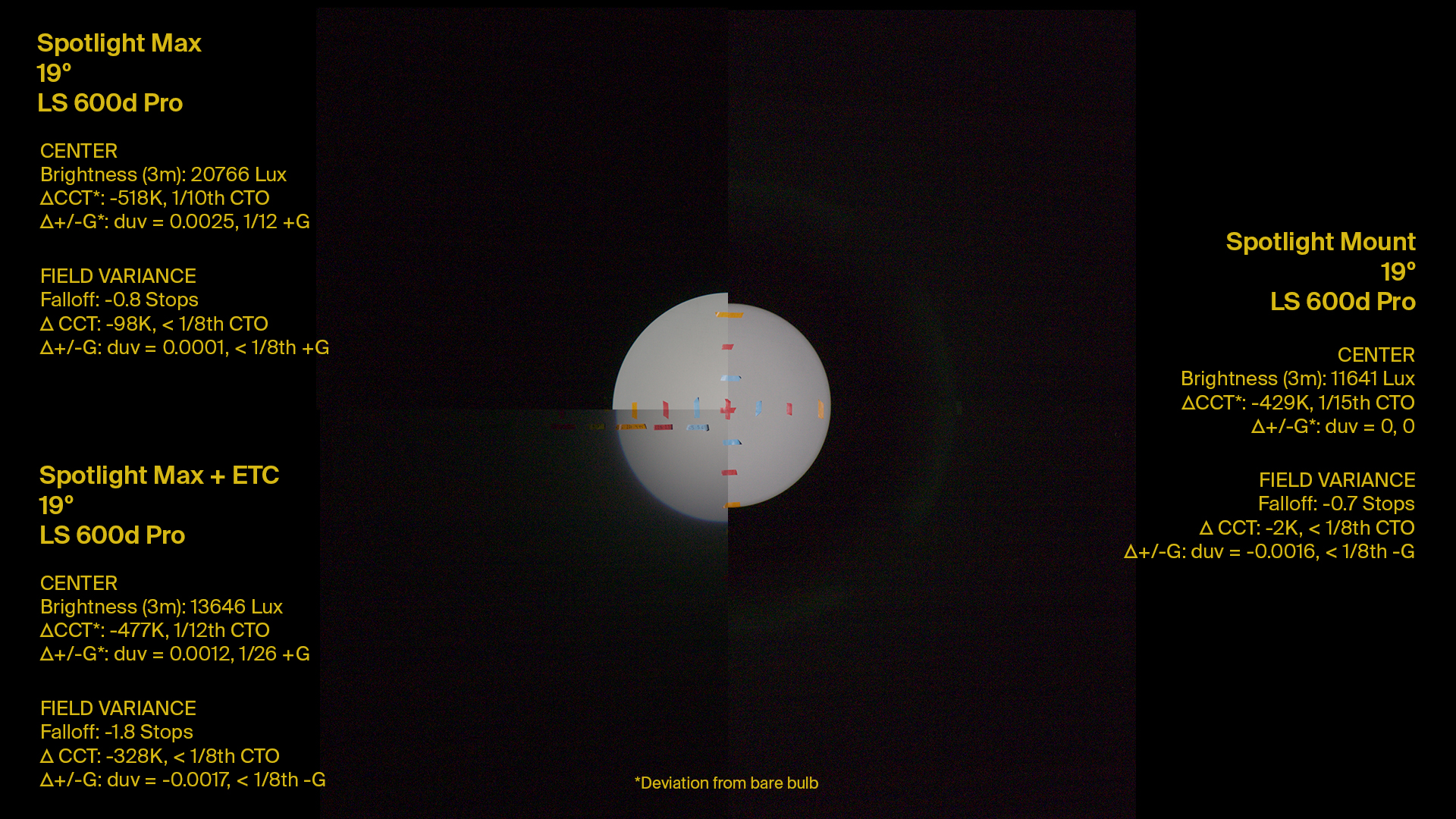
LS 600x at 5600K at 10’ on a 19° lens (center intensity):
Spotlight Max w/ Aputure 19°: 12,697 Lux
Spotlight Max w/ ETC 19°: 8,164 Lux
Spotlight Mount w/ Aputure 19°: 1,630 Lux
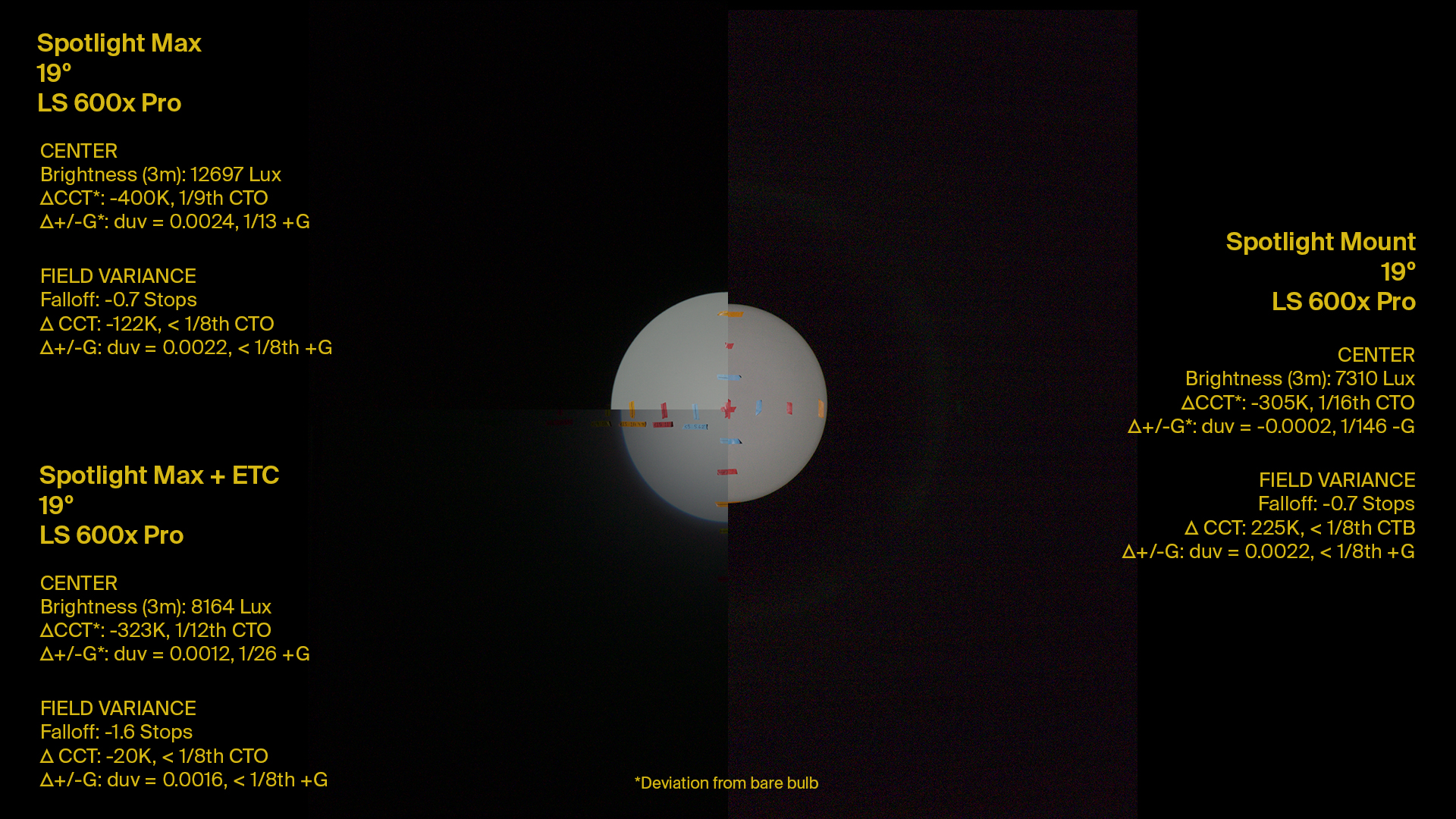
(Note that only LS 600 series lights were tested with the Spotlight Mount due to heat mitigation limitations. Aputure does not recommend its use with larger lights.)
LS 1200d at 10’ on a 19° lens (center intensity):
Spotlight Max w/ Aputure 19°: 25,632 Lux
Spotlight Max w/ ETC 19°: 17,325 Lux
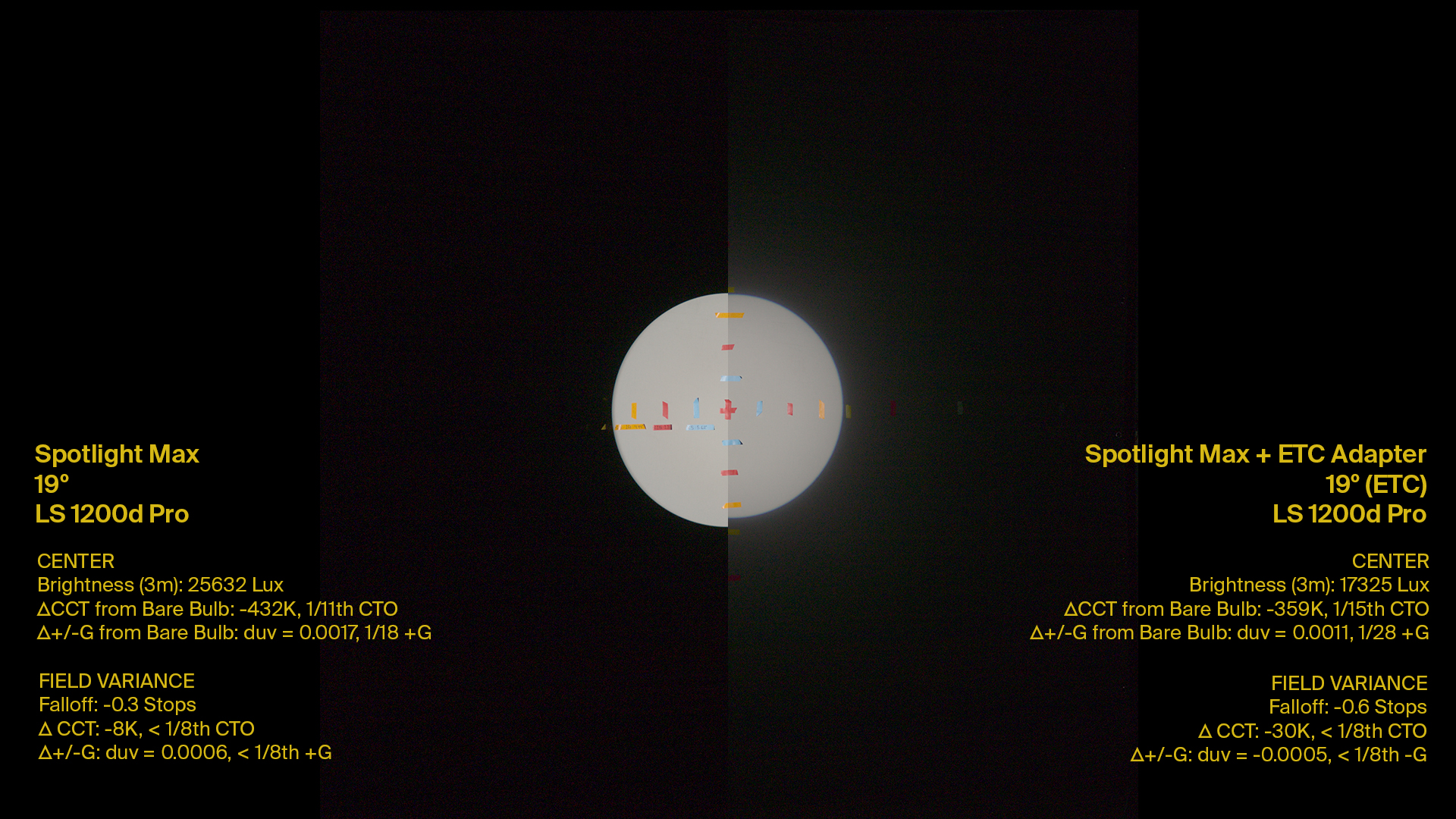
Performance With Prolycht Orion Lights
With Aputure’s acquisition of Prolycht it was important to match Aputure optical modifiers with Prolycht light fixtures. The particular designs of the Prolycht Orion COB lights make them uniquely suitable for use with the Spotlight Max. The Orion 300 FS has a narrow native beam angle so its relatively small wattage COB is all projected directly through the Spotlight Max with great efficiency. While this does lead to intensity falloff from center to edge, there is a great deal of intensity relative to the power of the light. On the Orion 675 FS, the recessed COB with its small oculus port replicates the narrow point source of a traditional ellipsoidal bulb, making for highly effective projection. The beam of the Orion 675 FS is remarkably even across the field as well as high in intensity.
(All measurements at 5600K at 10’)
Orion 300 FS
Spotlight Max w/ Aputure 19° Center Intensity: 19,580 Lux Intensity Falloff: 63%
Spotlight Max w/ Aputure 36° Center Intensity: 5,874 Lux Intensity Falloff: 72%
Spotlight Max w/ Aputure 50° Center intensity: 1,982 Lux Intensity Falloff: 71%
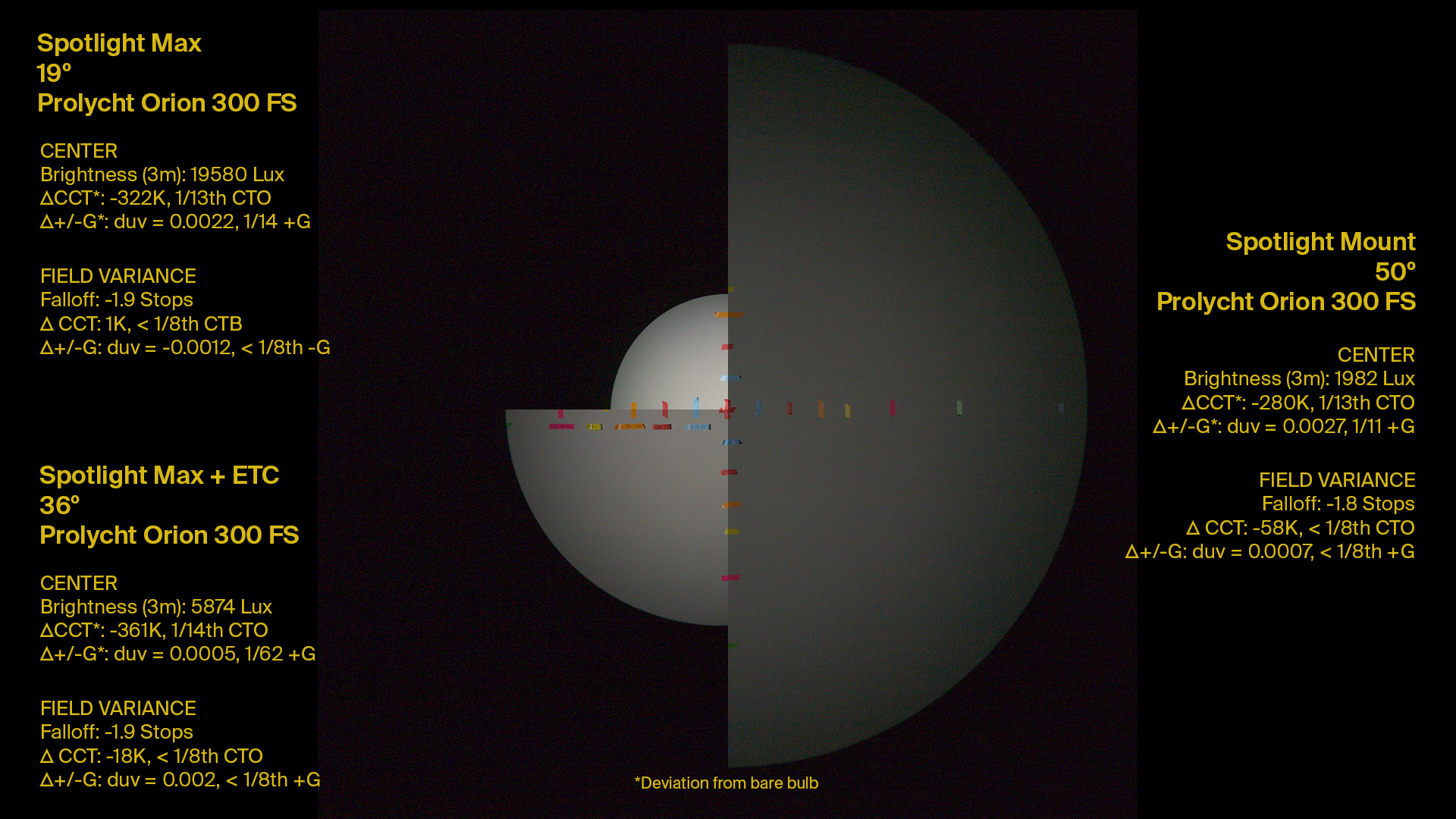
Orion 675 FS
Spotlight Max w/ Aputure 19° Center Intensity: 13,290 Lux Intensity Falloff: 30%
Spotlight Max w/ Aputure 36° Center Intensity: 3,655 Lux Intensity Falloff: 8%
Spotlight Max w/ Aputure 50° Center intensity: 1,377 Lux Intensity Falloff: 26%
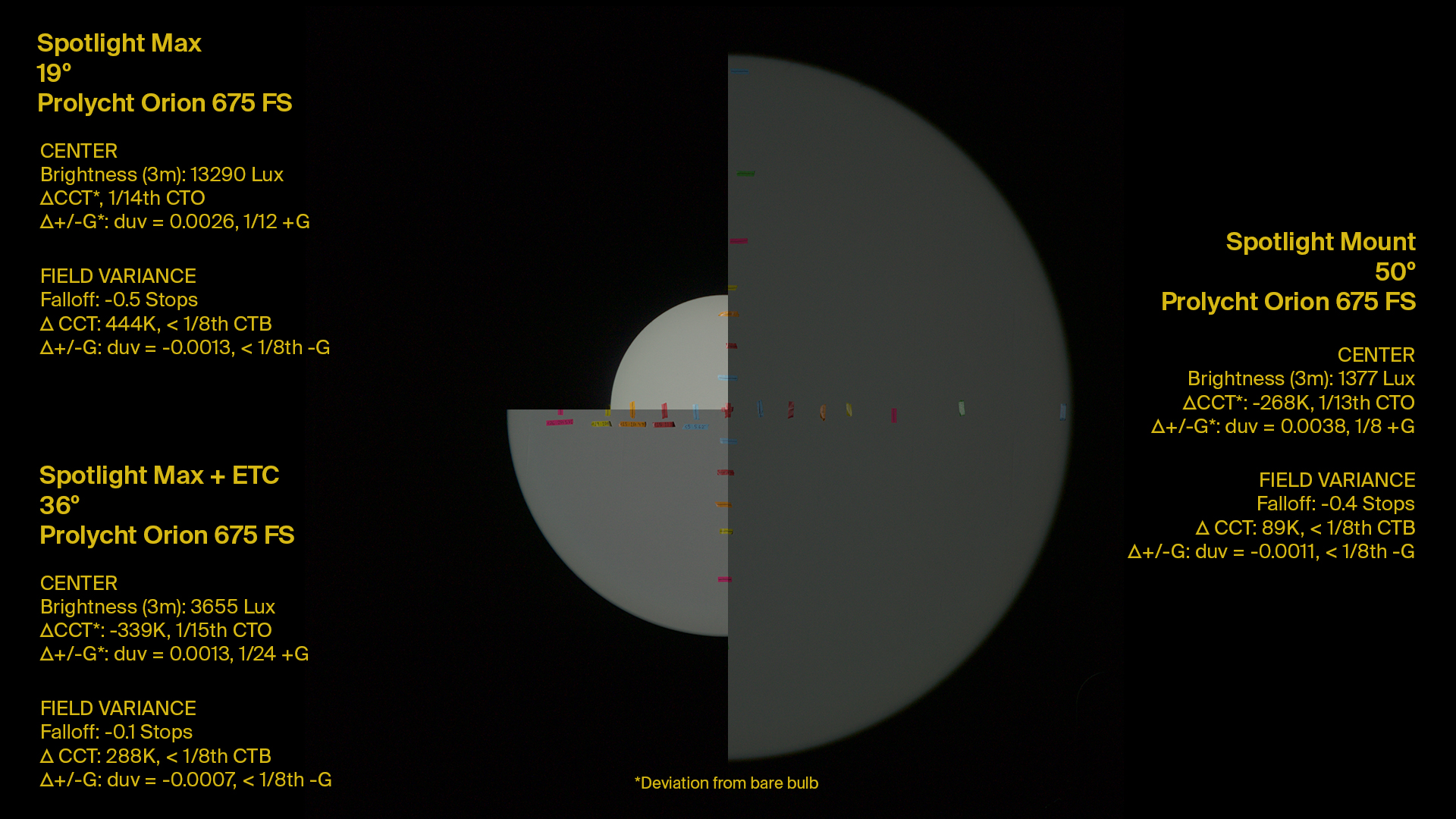
Spottiest of Spotlights
While the ETC Adapter provides the convenience and cost savings from the ability to use the wide range of widely available ETC standard and EDLT lenses, the great advantage to many will be the ability to project a high-intensity narrow beam using the 5° and 10° ETC lenses on the Spotlight Max. Punching these strong tight beams of light into reflectors, CLRS panels or bounced off coved whiteboards will be a popular use case. Here is how several lights performed in this configuration.
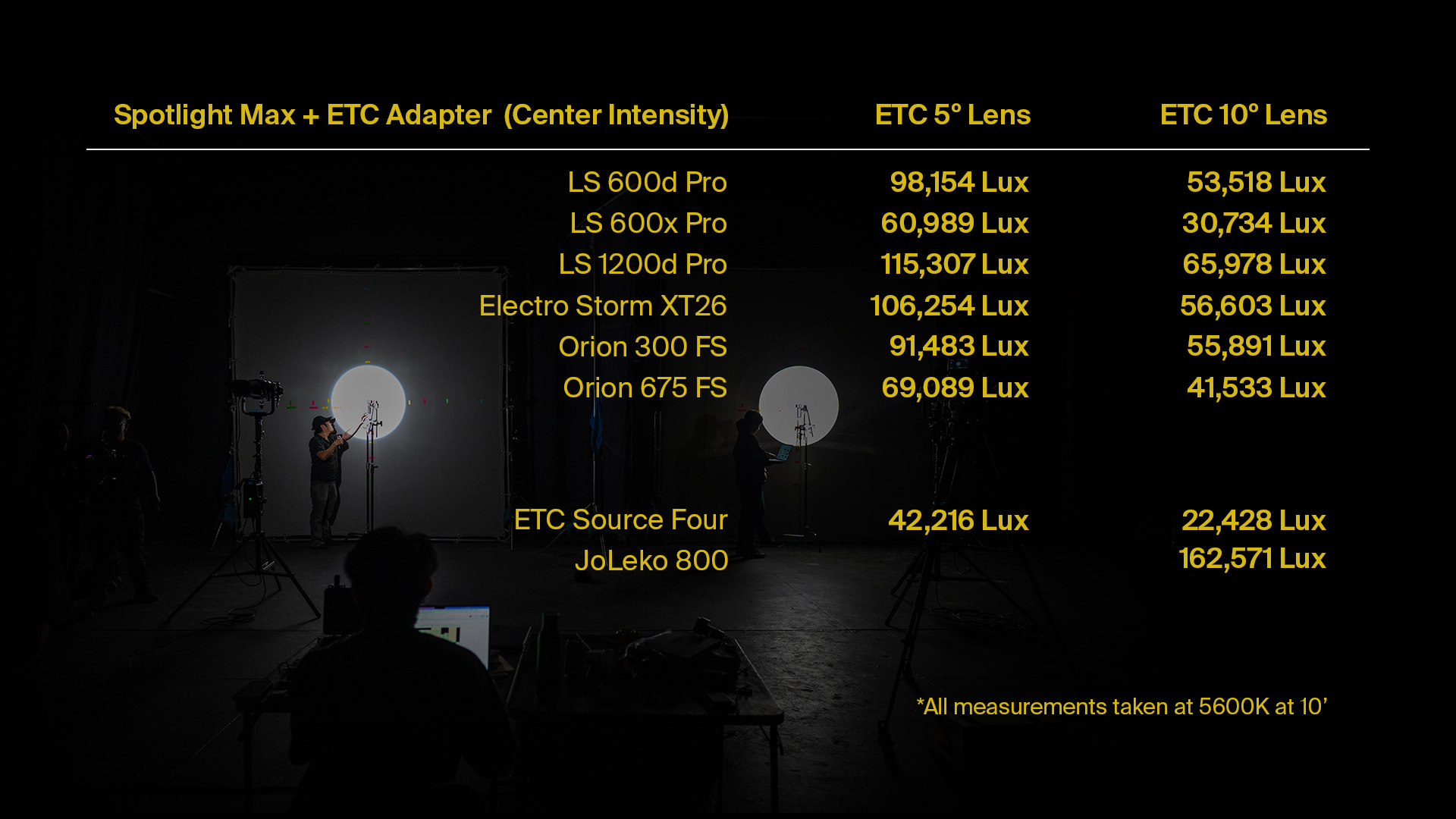
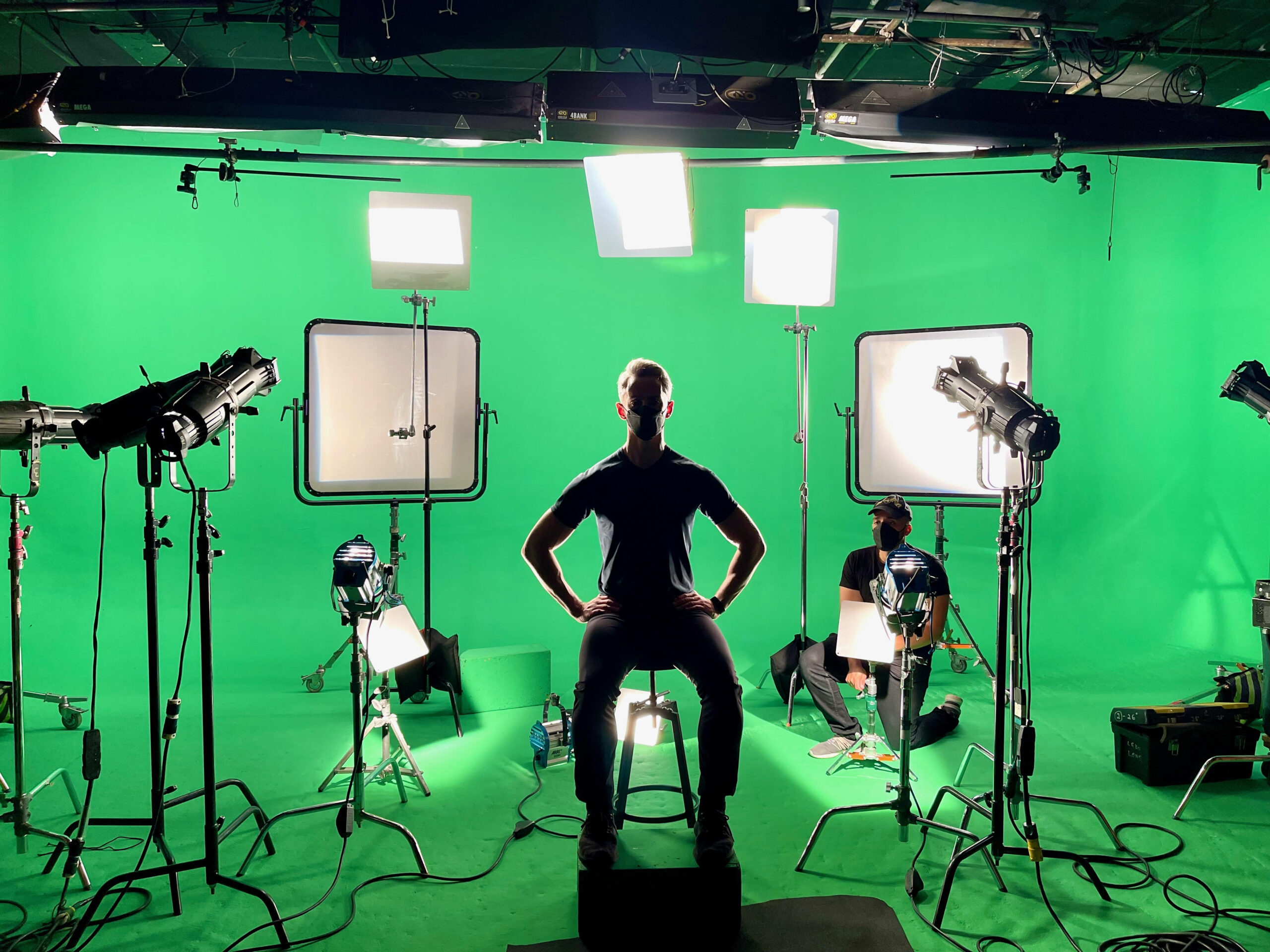
Aputure has published our complete testing data with many more measurements HERE.
More information on the Spotlight Max, HERE.
Purchase the Spotlight Max HERE.



